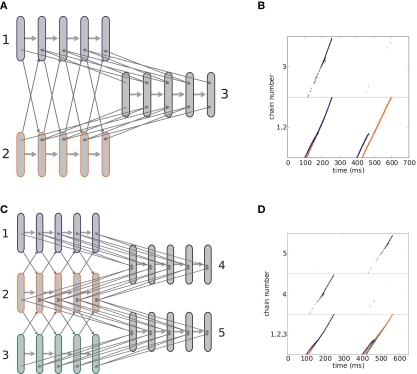Figure 3.
Detection and discrimination of binding states in networks of synfire chains. (A) Simple three-chain network. Each pair of chains (1,2), (1,3), and (2,3) are interconnected as shown in Figure 2A. The upper level chain (3, black) serves as a readout chain to detect the binding of the lower level chains (1, blue; 2, orange). (B) Detection of binding in the three-chain network in (A), coloring of spike time markers in the lower panel indicates chain membership of neuron. The two lower level chains are stimulated at t1 = 100 and t2 = 110 ms. The chains bind and activate the third chain. The lower level chains are stimulated again at t1 = 400 and t2 = 430 ms. In this case, the chains do not bind as the stimulus interval of 30 ms is too large. (C) Five-chain network. Here, three chains (1, blue; 2, orange; 3, green) constitute the lower level chains and two upper level chains (4–5, black) serve as readout chains. Interconnections are indicated by gray arrows. (D) As in (B), but for the five-chain network shown in (C). Chains 1 and 2 are stimulated at t1 = 100 and t2 = 115 ms. They bind together and activate the upper level chain 4. All three lower level chains are stimulated again at t1 = 400, t2 = 415, and t3 = 420 ms. In this case chains 2 and 3 bind, as they have the smallest inter-stimulus interval. Their binding causes the activation of upper level chain 5.

